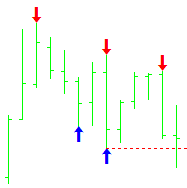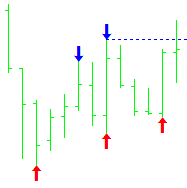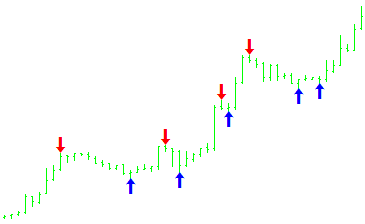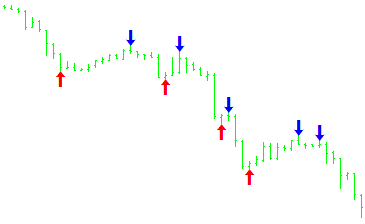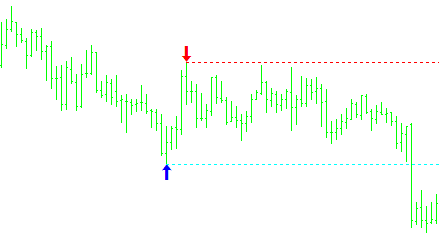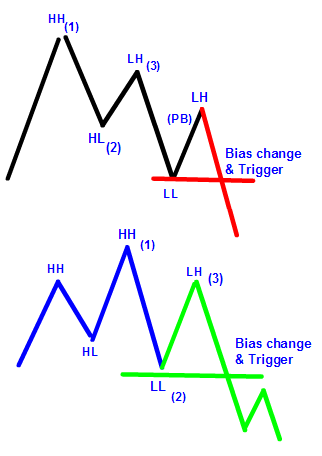Swing Highs and Lows The first thing that we need to recognise is what is a Swing High and Swing Low. This is probably the easiest part of price action and bar counting although the whole process gets easier with practice. |
Market Phases There are only three ways the market can go;
With the swing high/low definition now in mind we can start to build some layers on to the chart to identify these market phases and start to do a simple count of these swing highs and lows. In short
This may sound like child's play and a statement of the obvious but you will be surprised at how often people will forget these simple facts. One of the biggest questions I get asked is, which way is the market going? By doing a simple exercise you can see which way that price is going and decide on your trading plan and more importantly timing of a trade. What do I mean by timing? It may be that you are looking for a shorting opportunity as the overall trend is down but price on your entry time frame is still going up (making HH's & HL's). There is, at this stage, no point in trying to short a rising market until price action start to point down (making LH's & LL's. More on this shortly). Bias Changes
A Short or Bearish Bias Change occurs when the following sequence develops. HH>HL>LH>LL>LH The bias change is confirmed when price moves below the las lower low made as highlighted on the chart. Another way of saying this is 123 reversal and you are trading the pullback as your entry trigger (Red Line). There are a few variations of this pattern but this is quite simply a price action bias change in its simplest form.
A Long or Bullish Bias Change occurs when the following sequence develops. LL>LH>HL>HH>HL The bias change is confirmed when price moves above the last higher high made as highlighted on the chart. Another way of saying this is 123 reversal and you are trading the pullback as your entry trigger (Blue Line). There are a few variations of this pattern but this is quite simply a price action bias change in its simplest form. Trending Price Action After a bias change has been seen and confirmed, one of the phases that the market can then take is to start trending either up or down depending on the bias change previously. In the chart below we can see what price ideally looks like when price is trending up and trending down. Each phase shows price making HH's & HL's on its way up and LH's & LL's on its way down.
Ranging Price action Now this is where the chart can become interesting. By using the price action counting of the swing highs and lows we can know at a very early stage IFprice is going to start to develop range bound activity.
I don't mean all time highs/lows or new day/week/month highs/lows... just simply a new chart swing high or low. Price will start to stall and not make a new swing high/low and typically will stay contained within the last swing high and low that was made on the chart. Isn't that a simple definition? Range rule definitions
In the chart below you can see that from the left side of the chart price is making LH's & LL's all the way to the first blue arrow which in real time would be the latest lowest low. Price then moves higher to make a HH. These two swing levels have been highlighted. At the point of the chart, in real time, price needs to either start moving higher past the last swing high (red Arrow) making a new high OR move lower past the last swing low (blue arrow) making a new low. Until either of those things happens price will most likely remain range bound. In this example that is what happened.
Range considerations Some considerations for identifying ranges at an early stage in real time are;
By Philip Newton |






